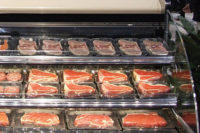Distinguishing between a restricted liquid line and a system overcharge in a commercial refrigeration system is very important for service technicians. To illustrate the difference between the two, we’re going to look at an R-134a commercial refrigeration system that contains a receiver and has a thermostatic expansion valve (TXV) as the metering device.
Here is a system check list of a restricted liquid line before the receiver:
| Measured Values | |
| Compressor Discharge Temperature | 270°F |
| Condenser Outlet Temperature | 90°F |
| Evaporator Outlet Temperature | 20°F |
| Compressor Inlet Temperature | 60°F |
| Ambient Temperature | 75°F |
| Box Temperature | 46°F |
| Compressor Amps | Low |
| Evaporator Pressure/Temperature | 0.28 inches Hg (-15°F) |
| Condensing Pressure/Temperature | 215 psig (135°F) |
| Calculated Values | |
| Condenser Split | 60°F |
| Condenser Subcooling | 45°F |
| Evaporator Superheat | 35°F |
| Compressor Superheat | 75°F |
When the restriction occurs before the receiver, the evaporator and compressor will be starved of refrigerant. The refrigerant that does enter the condenser will be trapped there, causing high condenser subcooling. This high subcooling will take up valuable condenser surface area, causing the condensing (head) pressure to elevate.
Symptoms of a restricted line before the receiver include:
- High discharge temperatures;
- High condensing (head) pressures;
- High condenser subcooling;
- High condenser splits;
- Low evaporator pressures;
- Low amp draws;
- Bubbly sight glass; and
- Short cycle the low pressure control (LPC).
System Analysis
High discharge pressures are caused from high compression ratios, which are caused from the elevated condensing temperatures. High condensing temperatures are caused from the liquid backed up in the condenser from the restriction between the condenser and the receiver.
High head pressures are caused from the liquid refrigerant being backed up in the condenser, causing a reduced condensing surface area. The restriction before the receiver is causing most of the liquid to remain in the condenser and slowly getting into the receiver. This is much different than if the restriction were after the receiver. A restriction after the receiver would cause most of the refrigerant to be in the receiver. This would cause low head pressures and low condenser splits, because the receiver is designed to carry all of the refrigerant plus a refrigerant vapor head for safety purposes.
With the restriction in the liquid line between the receiver and condenser, liquid will remain mainly in the condenser and cause high condenser subcooling. Do not confuse this with an overcharge of refrigerant. A system overcharged with refrigerant will not have low evaporator pressures and high superheats.
The elevated condensing pressures and temperatures will cause the temperature difference between the surrounding ambient and the condensing temperature to increase. This temperature difference is the condenser split.
Because of the restriction in the liquid line, the receiver, TXV, and evaporator will be starved. The compressor will keep pumping trying to get vapors from the evaporator, which will draw the evaporator pressure into a low pressure. How low the suction pressures will get will depend on the severity of the restriction.
Amp draws will usually be low in this situation because of the compressor being starved of refrigerant. Also, the low density of the small amount of refrigerant vapors coming into the compressor will cause low amp draws.
The sight glass will be bubbly because of the starved receiver and liquid line after the receiver. Depending on the severity of the restriction, the sight glass may have very little refrigerant running through it and look empty.
Since the compressor is starved of refrigerant, if a low pressure control is used to cycle the compressor, the low pressure control (LPC) will cycle the compressor off and on from the low (evaporator) suction pressures.
Before adding any refrigerant to a system, service technicians should first make sure the problem is not a liquid line restriction before the receiver.











